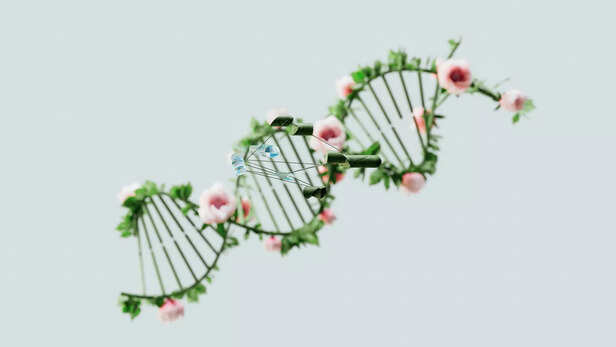Why Your Heart Chooses People Your Mind Can’t Explain
Megha Jangra | Aug 31, 2025, 21:35 IST
Love
( Image credit : Freepik )
Love feels spontaneous, but attraction is shaped by science. From biology to psychology and social influences, hidden forces quietly guide us toward certain people. Our genes, brain chemistry, shared values, cultural standards, and timing all play a role in who catches our eye and who doesn’t. Understanding why we fall for certain people doesn’t take away the magic of love, it helps us appreciate it more deeply. Attraction may begin with chemistry, but it’s human choice and emotional connection that transform fleeting sparks into lasting relationships.
We’ve all asked ourselves at some point: Why am I drawn to this person? Maybe it’s the way they smile, a spark you can’t explain, or a strange sense of comfort in their presence. While romantic attraction feels spontaneous, scientists have discovered that it’s far from random. Hidden beneath every crush or deep connection are patterns, signals from our biology, cues in our environment, and subtle psychological pulls that quietly guide our hearts.
Understanding these forces doesn’t take away the magic of love; it gives us a deeper appreciation for it. Attraction is not just about chance, it’s a story written in our genes, shaped by our experiences, and influenced by the world around us.

Attraction begins deep in the body. Humans subconsciously seek traits that signal health and strong genetics — like symmetrical features, healthy skin, or a confident posture. Even scent plays a hidden role. Research suggests we may prefer the natural scent of people whose immune system genes differ from ours, signaling better genetic diversity.
And then there’s chemistry in the literal sense. Neurotransmitters like dopamine give us a thrilling rush when we’re around someone we like, while oxytocin helps us feel safe and connected, especially with prolonged touch or emotional intimacy. This blend of biology explains why love can feel both exciting and comforting at once.

Attraction isn’t just about how someone looks; it’s also about how they make us feel. We’re often drawn to people who share our interests, values, and humor because similarity creates a sense of safety and understanding. Familiarity plays a role too, the more we see someone, the more likely we are to find them attractive, a phenomenon called the “mere exposure effect.” On the other hand, a little mystery or challenge can heighten interest, making someone feel exciting and unique. Sometimes opposites attract as well, with complementary traits, like calmness balancing adventure, creating a sense of harmony and curiosity that deepens connection.

Love stories are shaped not only by who we are but also by the world we live in. Cultural standards influence what we consider attractive, body types, skin tones, hairstyles, even gestures. Timing and proximity play a major role too; we’re more likely to meet potential partners within our own networks, classmates, co-workers, or friends of friends.
Our past experiences matter as well. Traits we grew up around, whether kindness, humor, or particular physical features, may unconsciously influence who feels “right” to us later in life.

While attraction can be powerful, it doesn’t decide the future. It sparks interest, but it’s compatibility, shared effort, emotional safety, and timing that turn sparks into relationships. Sometimes we’re deeply drawn to someone who isn’t good for us — proof that chemistry and compatibility are not the same thing.
We often think of love as unexplainable, but science reveals just how many factors quietly shape our hearts. Biology, psychology, culture, and circumstance all combine in a delicate balance that decides who catches our eye and who doesn’t.
But perhaps the most beautiful part is this: no matter how much science explains, love still holds a touch of mystery. Attraction may be influenced by invisible forces, but it’s human choice — the decision to nurture, respect, and grow together — that turns fleeting chemistry into lasting love.
Understanding these forces doesn’t take away the magic of love; it gives us a deeper appreciation for it. Attraction is not just about chance, it’s a story written in our genes, shaped by our experiences, and influenced by the world around us.
1. The Role of Biology

Love in Our Genes
( Image credit : Unsplash )
Attraction begins deep in the body. Humans subconsciously seek traits that signal health and strong genetics — like symmetrical features, healthy skin, or a confident posture. Even scent plays a hidden role. Research suggests we may prefer the natural scent of people whose immune system genes differ from ours, signaling better genetic diversity.
And then there’s chemistry in the literal sense. Neurotransmitters like dopamine give us a thrilling rush when we’re around someone we like, while oxytocin helps us feel safe and connected, especially with prolonged touch or emotional intimacy. This blend of biology explains why love can feel both exciting and comforting at once.
2. The Psychology of Attraction

Love and Hate
( Image credit : Unsplash )
Attraction isn’t just about how someone looks; it’s also about how they make us feel. We’re often drawn to people who share our interests, values, and humor because similarity creates a sense of safety and understanding. Familiarity plays a role too, the more we see someone, the more likely we are to find them attractive, a phenomenon called the “mere exposure effect.” On the other hand, a little mystery or challenge can heighten interest, making someone feel exciting and unique. Sometimes opposites attract as well, with complementary traits, like calmness balancing adventure, creating a sense of harmony and curiosity that deepens connection.
3. Social and Cultural Influences

Modern Connections Shaped by Culture
( Image credit : Unsplash )
Love stories are shaped not only by who we are but also by the world we live in. Cultural standards influence what we consider attractive, body types, skin tones, hairstyles, even gestures. Timing and proximity play a major role too; we’re more likely to meet potential partners within our own networks, classmates, co-workers, or friends of friends.
Our past experiences matter as well. Traits we grew up around, whether kindness, humor, or particular physical features, may unconsciously influence who feels “right” to us later in life.
4. Attraction Isn’t Destiny, It’s a Starting Point

Positive young ethnic couple embracing
( Image credit : Pexels )
While attraction can be powerful, it doesn’t decide the future. It sparks interest, but it’s compatibility, shared effort, emotional safety, and timing that turn sparks into relationships. Sometimes we’re deeply drawn to someone who isn’t good for us — proof that chemistry and compatibility are not the same thing.
The Takeaway
But perhaps the most beautiful part is this: no matter how much science explains, love still holds a touch of mystery. Attraction may be influenced by invisible forces, but it’s human choice — the decision to nurture, respect, and grow together — that turns fleeting chemistry into lasting love.
